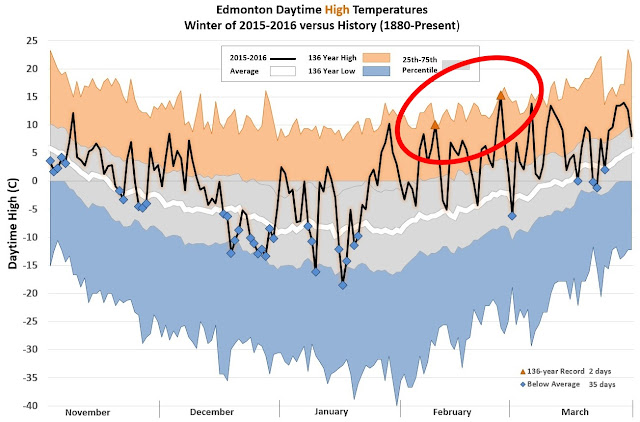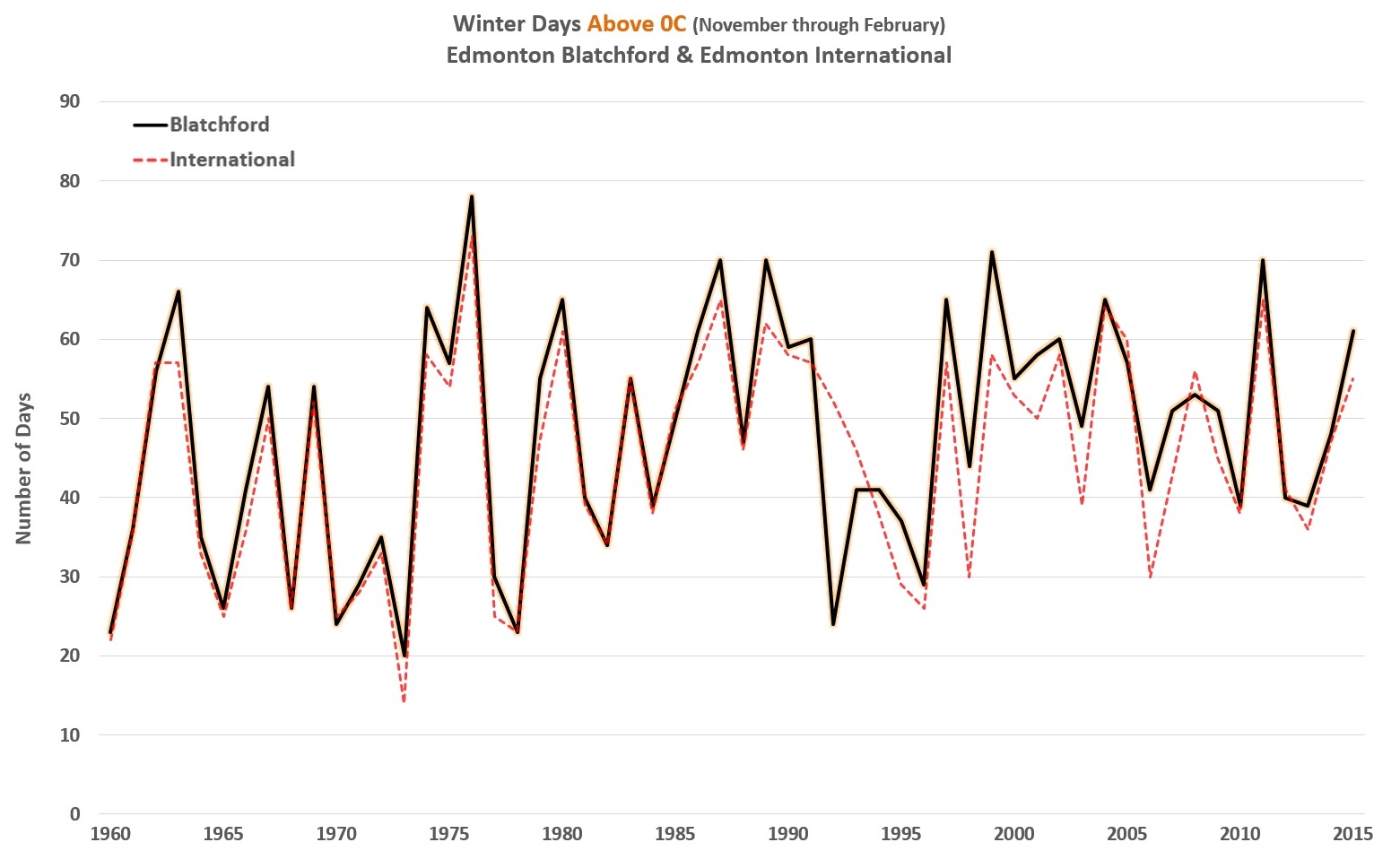These are the daily High temperatures for 2015-2016 compared to those going back through 1997-1998. It's a surprisingly pretty chart, but there is a lot of stuff going on, so it needs some explanation.
The black line is 2015-2016, and the white line is the average for the period. That average is similar to the "normals" that are mentioned in weather reports, but those typically take 30 years into account, while here I am just using data from the current Blatchford weather station which only goes back to 1997.
The thick grey band is the 25th through 75th percentiles. This just means that half of the time the daily high will fall within that range. Then there are the highest and lowest values recorded since 1997. And I have also included the 2nd highest and 2nd lowest, because some of the extreme days really are extreme outliers.
So with that said, looking at the history we see that things cool from November through mid-January, and then start to warm up again heading into spring.
This year the Highs were above average for most of the winter, and they didn't get close to any of the coldest values. They only fell below the 25th percentile on a handful of occasions.
The Low temperatures tell a similar story, being above average for most of the winter, except for a stretch from mid-December through mid-January where temperatures were just a bit below normal.
Here are the same charts with some of the dates highlighted, so that things pop a little bit more.
This year there were 11 days that recorded the warmest temperature for the period. 11 days might sound like a lot, but since we are only going back to 1997 we would actually expect that every year will record about 8 of those. So while 11 is a bit more than that, it's not huge.
In terms of Highs that were below the average, there were 43 out of 152 days, or 28%. And none of those came close to the coldest temperatures that had been recorded for the period.
The daytime Lows are fairly similar. 17 days had the warmest low temperatures recorded since 1997. Only 38 days were below the average. And none were close to the coldest temperatures.
Here was have 2015-2016 compared against just the last 5 years. I'm not concerned about the specifics of 2010 through 2014, so they are all in the background to make this year stand out.
And what stands out is that 2015-2016 was very much at the top of the pack for November, February and March. And it was only for mid-December through late-January that temperatures fell to more normal levels.
Thinking back to my look at "
A winter without -20C?", in the last 5 years 2010-2011 was a particularly cold winter, and 2011-2012 was a warm one. So here we have those two years compared against 2015-2016.
The biggest difference between 2010-2011 and the two warm years is just how cold February and March were, with weeks of -20°C and -25°C lasting until almost the start of spring. That year had almost a month-and-a-half of extra
real winter.
Of the two warm years, 2011-2012 was actually more consistently warm than 2015-2016. It didn't have the month long December-January coldsnap that we had this year. But it did have a handful of very cold days, dropping below -30°C in mid-January.
The whole reason that I started looking at weather data this year was because of the little chinook that we got in mid-January. Everyone was saying "Don't get used to it, because it never gets this nice in January." But I've been running and walking and cycling for enough winters now that I thought, "waitaminute, doesn't this always happen?"
And here we see that all three of these years did have chinooks in January - and not just small ones either, but with temperatures reaching 8°C to 10°C. And going back to 1997-1998, 18 of the 19 January's had a week or more above freezing. 1999 was the only one that didn't, and even it managed a few scattered days at 5°C. So this blog was ultimately started because of one fairly typical week, in a slightly colder than average month, in an otherwise warm winter.
Finally, here is a comparison of 2015-2016 against the temperatures going all the way back to old-timey 1880. This is just for fun, because we know that temperatures have changed since then, so it's not really a fair comparison.
Looking at the 136-year values, we did set a few warm records this year, but obviously no cold ones. And with over a century of data the 25th-75th percentile band has widened a bit, so that the winter of 2015-2016 barely drops below the 25th percentile.
We've seen previously that Edmonton's cold temperatures used to be a
lot colder, while the warm temperatures haven't changed as dramatically. And we see that here as well, with typically a 20°C gap between this year's coldest temperatures and the all-time record lows.



































